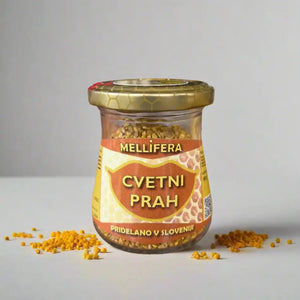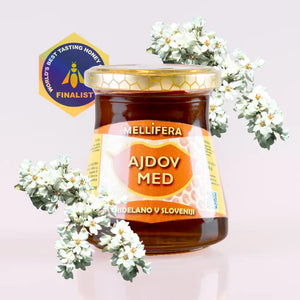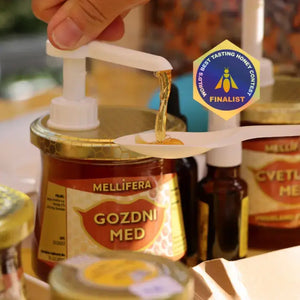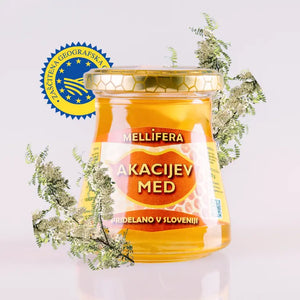
Honey has been valued for thousands of years as a natural sweetener that is not only delicious, but also rich in nutrients, antioxidants and many other beneficial substances. Today, when the offer on the market is very diverse – from flower and acacia to forest and chestnut honey – many of us wonder which honey to choose. In this article, we will present the nutritional values of different types of honey, their specific properties and impact on health.
1. General nutritional values of honey
Honey is essentially composed of simple sugars (glucose and fructose), water, enzymes, minerals, vitamins, and phytochemicals. Its nutritional value and content of beneficial compounds depend largely on the type of pollen and nectar that bees collect.
- Simple sugars: Honey is a source of quickly available energy. On average, it contains around 80% sugars, with the ratio of glucose to fructose varying depending on the type of honey.
- Minerals and vitamins: It contains minerals such as potassium, iron, calcium, magnesium and phosphorus in smaller amounts, as well as B vitamins, vitamin C and various antioxidants.
- Enzymes: Bee enzymes break down sucrose into fructose and glucose and contribute to the unique taste and aroma.
- Antioxidants: The polyphenols, flavonoids, and organic acids in honey help strengthen the immune system and have anti-inflammatory and antibacterial properties.
2. Nutritional values of different types of honey
2.1 Flower honey
Flower honey is obtained from the nectar of various plants and is usually milder in taste and lighter in color. Due to its diverse floral origin, it contains a wide range of minerals, vitamins and antioxidants. It often has a higher fructose content, making it slightly sweeter and slower to crystallize. Its versatile nutritional value makes it great for everyday use, from breakfast to tea ceremony. Read more about flower honey u .
2.2 Acacia honey
Acacia honey is known for its very light, almost transparent color and delicate, mild taste. The fructose content in acacia honey is higher than the glucose content, which means that this type of honey crystallizes very slowly. Due to its high fructose content and gentle profile, it is ideal for diabetics with a controlled diet (of course, after consulting a doctor) and for anyone who wants a lighter alternative to regular sugar. If you want quality sweetening with a delicate taste, try our acacia honey .
2.3 Forest honey
Forest honey is made from the nectar of conifers and deciduous trees rather than from flower nectar. It is often darker, richer, and contains more minerals, such as iron and potassium, as well as more antioxidants. It has a more intense, slightly resinous flavor, which is a result of the different sources of honey in forest environments. Due to its rich mineral composition and high antioxidant content, forest honey is known as the “superfood” of honeys.
In addition, forest honey is a great choice for preparing delicious traditional desserts. If you want to taste the true magic of nature in a dessert, check out our Recipe: Sugar-free gingerbread cookies with forest or chestnut honey . You can find it here: Gingerbread recipe . If you want to experience the unique taste of rich nature, try our forest honey .
2.4 Linden honey
Linden honey, with its characteristic linden aroma and light yellowish color, is known for its refreshing and slightly mentholated taste. Among the nutrients, flavonoids and essential oils that bees collect from linden flowers stand out. This type of honey is considered a useful support for colds, coughs and other respiratory problems, as it soothes the throat and strengthens the immune system. If you want to enrich your home pharmacy with a wonderful natural preparation, choose our linden honey .
2.5 Chestnut honey
Chestnut honey is darker, has a distinctly bitter and rich taste. Compared to other honeys, it contains more minerals (especially iron) and has a higher proportion of antioxidants. Chestnut honey is great for anyone looking for a refreshing, strong taste and a mineral-rich dietary supplement. Its texture and specific taste make it an excellent choice for culinary adventures, e.g. for marinating meat or making sauces. If you value intense flavors and nutrients, try our chestnut honey .
2.6 Buckwheat honey
Buckwheat honey is characterized by its dark brown to almost black color and intense, slightly earthy flavor, which many also describe as slightly nutty. It is produced from the nectar of buckwheat flowers, which has a characteristic aroma and rich nutritional value. Buckwheat honey is known for its high content of antioxidants and minerals, especially iron, which is why it is often recommended as a strengthening supplement to the diet.
- Due to its thicker consistency and dark color, it crystallizes quickly, but this does not diminish its value.
- The taste is distinct and specific, which is why it is often used in cooking to prepare sauces, baked desserts, or as a topping for pancakes and waffles.
- Many honey lovers also value it as a support for boosting the immune system and improving overall well-being.
Read more about buckwheat honey here .
2.7 Ivy honey
A rare and special type of honey obtained from the nectar of the ivy plant. Due to its high glucose content, it crystallizes quickly. A spoonful of ivy honey can help quickly relieve cough symptoms. It has a beneficial effect on fever, helps relieve cramps and is good for detoxifying the body. If you want to experience this unique gift of nature, try our ivy honey .
3. How to choose the right honey for yourself?
When choosing a honey, consider both taste and nutritional value. If you need honey to sweeten your tea, acacia honey is a great choice. However, if you want a rich source of minerals and antioxidants, reach for forest chestnut or buckwheat honey. For general use in the kitchen and as a healthy addition to your diet, we recommend flower or linden honey.
Tip: Always choose local, raw honey that has not been heat-treated. This way you will receive the most nutrients and support Slovenian beekeeping and bee conservation.
4. Health benefits and uses of honey
- Antibacterial : Honey has antibacterial properties, so it can help heal wounds (chestnut honey) and soothe an irritated throat.
- Source of quick energy: Due to its simple sugars, it is an excellent quick source of energy before sports activity or as a quick “pick-me-up”.
- Immune system support: The antioxidants, vitamins, and minerals in honey strengthen the immune system and contribute to better well-being.
- Culinary: Honey is used in cooking as a natural sweetener, in sauces, marinades, desserts and drinks. Its wide range of flavors allows you to adapt it to a variety of dishes.
Conclusion
The nutritional value of different types of honey depends on their origin, color, taste, and content of certain minerals, vitamins, and antioxidants. Whether you choose floral, acacia, linden, forest, or chestnut honey, this natural treasure will provide you with a wealth of nutrients. The key to maximum benefits is in moderate, regular use, choosing high-quality, raw honey, and enjoying the variety of flavors that this bee gift of nature offers.

Do you want the real thing?
How can you find real unheated honey?
We make sure that our honeys retain their natural strength, as we have a line that is never heated. This ensures that they are full of flavor and nutrients - just as the bees create them. And of course, it is Slovenian!
Check here 👉🏻 https://mellifera.si/collections/nesegreti-med



